How to Compare and Contrast: Petunia-Calibrachoa and Petchoa
Why would you want an alternative to the petunia? And why will you want to compare these three? Every gardener knows the petunia, and we may feel that we have no reason to want an alternative. The petunia is beautiful; and brings charm, color, and scent to the garden. Modest in price, it’s simple to grow, blooms all season and pollinators covet it! Why change it?
But no plant is perfect and now growers have developed two alternatives, the calibrachoa and the petchoa to fill the specific needs of our gardens. Here is how to choose the perfect trumpet-shaped flowers to put in your color garden.
The petunia is a genus of plants containing about 20 species, within the Solinaceae family. Solinaceae is the nightshade family: potato, tomato, and belladonna! Strange bedfellows! In the field of growing annual plants for brilliant color, the petunia is almost perfect. We found the first petunias in South America sometime around the 1800s and they reached almost instant success, and never stopped!
At the same time, plant hunters discovered a similar flowering plant, the calibrachoa. It was identified, early on as difficult to grow and it did not see much use until the 1990’s. Selective breeding has made it an attractive alternative to the petunia. Sometimes in plant history, this just happens. We don’t see a use for an introduced plant for a long time, and then some clever breeder improves what bothers us.
More recently, some bright spark had the idea to create a new hybrid plant, called the petchoa, as the name implies a combination of the first two. Who thought it would be a great idea to combine the petunia and the calibrachoa? I’m not sure, but we are glad they did!
Comparing And Choosing Among The Plants: Petunia, Calibrachoa, Petchoa
So which is the best? The answer is (as often happens in the world of horticulture) ‘it depends‘, all three share similar benefits but in different proportions. The good news is that depending on what features are most important to you, there are some choices in the color garden that we did not have before.
Here are the plants, first with a summary and then a comparison you can use to make your choices. Where I garden, in balmy South Florida, zone 10b, they are all choices for our mild winters and they have a more limited use for us as our sticky summer comes. But they can extend our season and create new options, and who doesn’t like that in the garden?
In hardiness zones, everywhere else, plant these in the spring and you will have blooms every day until fall.
The Three Plants: Compared and Contrasted
Petunia
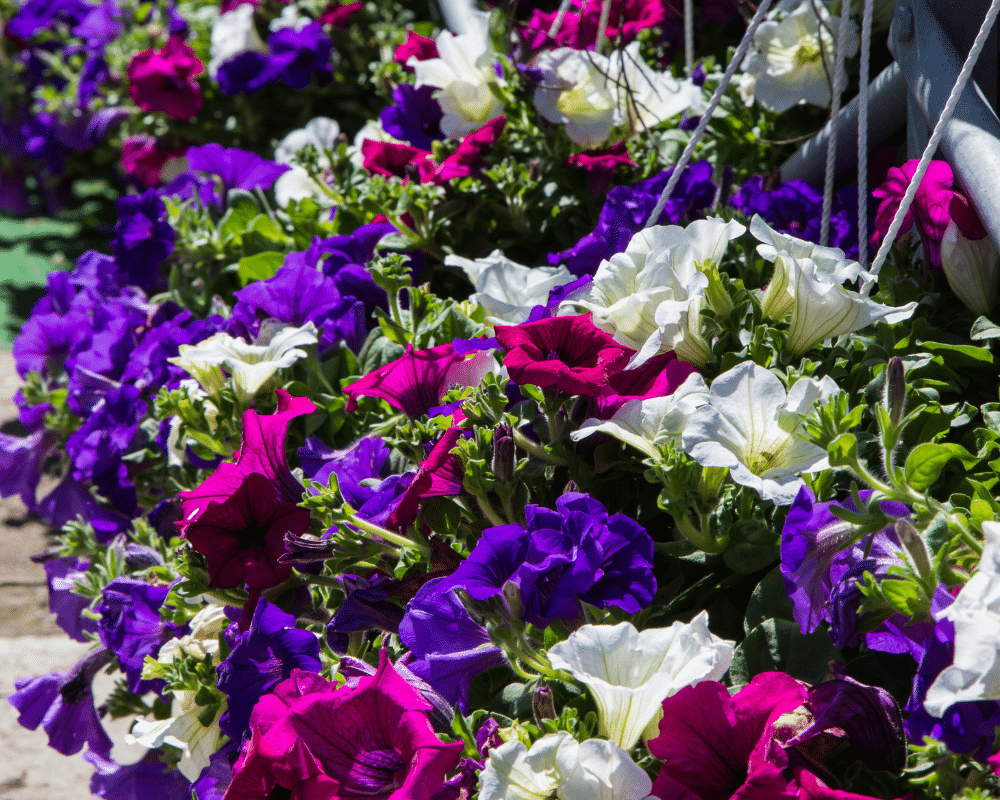
If you had to define the perfect color annual for your beds, borders, containers, and window boxes you might likely pick the petunia. Big, plentiful blooms in a trailing and mounding shape, they never fail to get a compliment at the front door! Why would we want to improve the petunia? Well, there are a few complaints. The leaves are sticky, which means plenty of time devoted to deadheading spent blooms, and they melt in the rain. In addition, while they come in many beautiful colors we people who grow things ornamental can’t resist something new and unique.
Calibrachoa
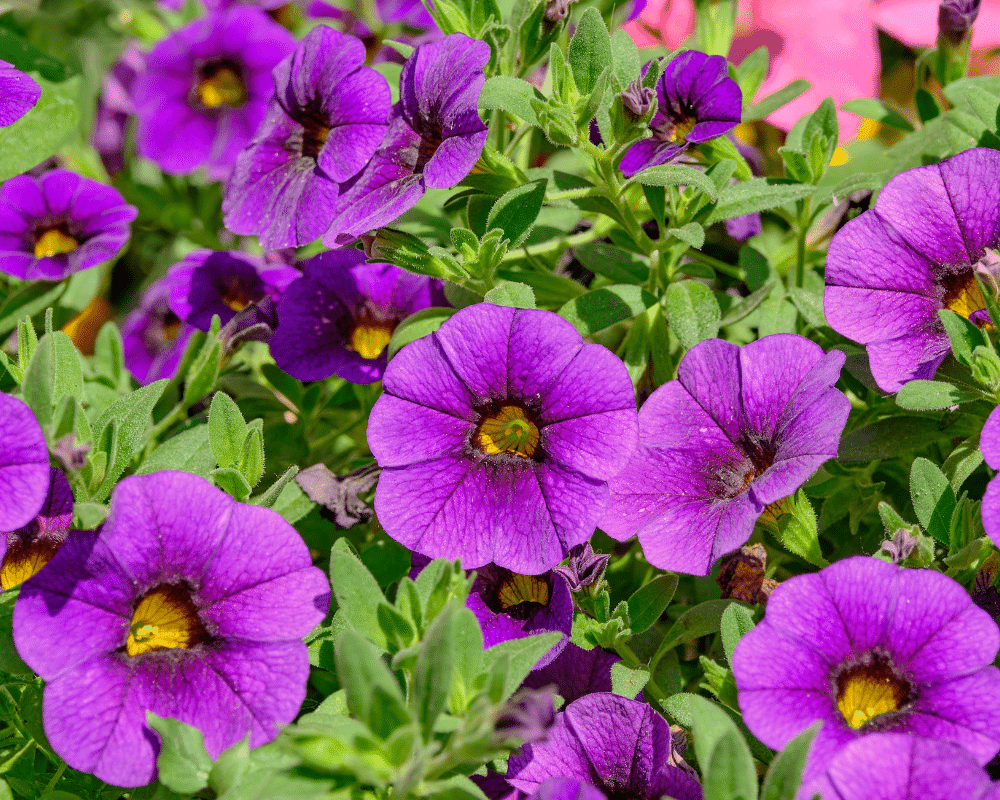
The calibrachoa was undervalued for a very long time and began its renaissance in the 1990s, today its success shows no sign of stopping, It is not a miniature petunia, it is a different plant in a different genus. Also a member of the Solinaceae family, it is, like the petunia, an evergreen, short-lived tropical perennial (in zones 9-11) and commonly grown as a color annual, in a wide variety of climates.
(In the UK the petunia and the calibrachoa are considered two species within the same genus.) Why the difference? The two plants have been taxonomically separated since 1825 and in 1985, scientists determined that the petunia has 14 chromosomes and the calibrachoa has 18. This distinction is debated by botanists but the distinction stands in this country.
To me, as a gardener, they are both useful additions to the color garden and the distinctions that I need to work with are the blossom size, scent, stickiness of foliage, and the finicky nature of the calibrachoa regarding soil pH.
Calibrachoa flowers are similar but smaller than the petunia, they can be grown in a wider range of colors than the petunia. Both plants have strict requirements for regular water, and superior drainage. Also, both are sun-loving. The calibrachoa has some distinct differences. They are far more sensitive to pH in the garden, and this makes them less useful in garden beds, but invaluable in containers. Like the petunia, they will fail in the absence of regular water and drainage.
The Importance Of Water To Calibrachoa
Unlike the petunia, the calibrachoa is particularly sensitive to any failure in regular watering. They may need less water than the petunia but do not forget! You can lose a beautiful plant with surprising speed!
Where the calibrachoa is distinctly superior to the petunia is that leaves are not sticky and this makes them far less likely to be rain-damaged. If you like the petunia and have problems with your plants being damaged by humidity and rain this may be the color annual plant for you!
The calibrachoa grows best in a pH of 5.5-6.2 and appears more unforgiving of drainage failures than the petunia. It performs its best in any kind of container where you can control moisture and drainage. The plant’s dense, masses of color prove itself most successful in pots, hanging baskets, and window boxes.
If deadheading petunias is something you would rather avoid, the calibrachoa, without the sticky leaves is far more self-cleaning. In addition, if you do not fail with the water and drainage, which you can solve with attention or drip systems and container gardening you can consider the calibrachoa, a low-maintenance plant.
Petchoa
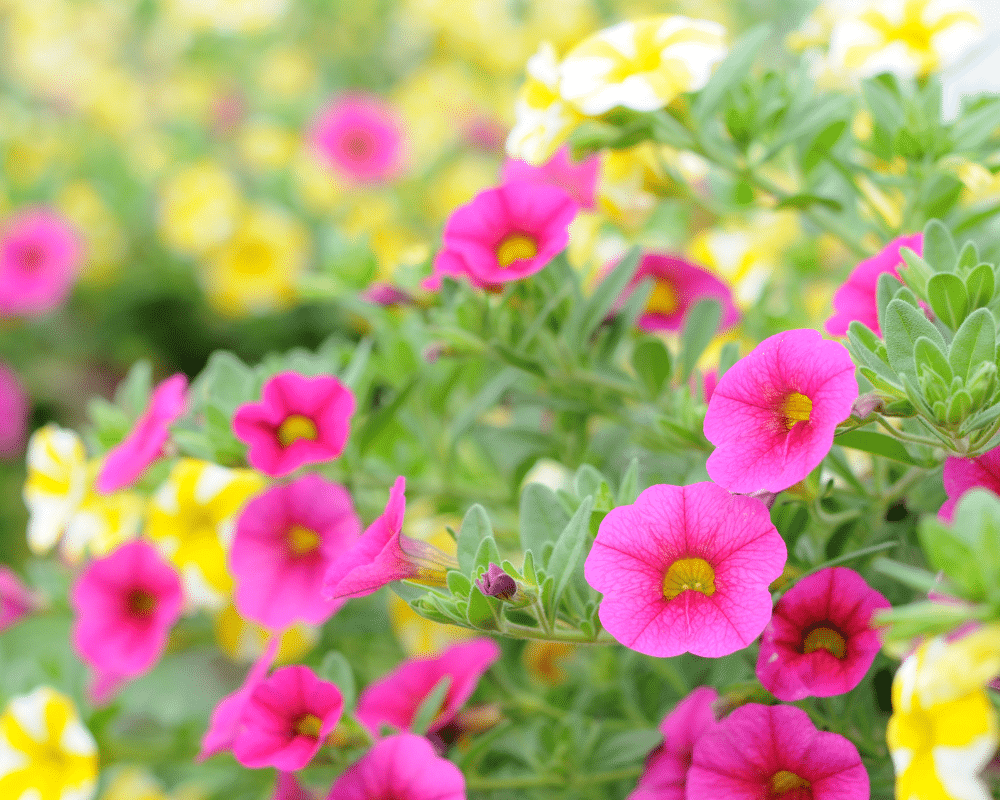
The petchoa is a cultivar and not a natural variety. It was developed to be the ‘best of both worlds,’ offering the best features of each plant.
First developed by the plant breeder, Danziger, whose trademark offering is ‘Calitunia,’ the plant has specific features. Also bred by the breeder Sakata, their plants are trade named ‘Supertunia.’
The plant is specifically designed to produce a dense ball of color for our gardens. Its growth habit is semi-trailing and compact. When a plant is defined as compact, it means that there is a very short distance between the leaf internodes, thus producing a dense display of color. Compact is a feature we all want to have in color annuals!
- The flowers are 1-1.5″ in diameter. (The petunia bloom can reach 4-5″ wide, the calibrachoa flower is smaller, at about .5.”)
- Like the calibrachoa the leaves of the petchoa are not sticky and are heavier than the petunia, this makes them more self-cleaning and resistant to heavy rain than the petunia.
- The petchoa is less sensitive to higher pH than the calibrachoa.
- Petchoa is also more heat tolerant than the calibrachoa.
How Does The Thoughtful Gardener Choose Among The Choices?
Compare and Contrast for Yourself: Petunia, Calibrachoa, Petchoa
In the greater world of living things, these choices among three simple plants are a minor matter, we all realize. But a good choice in the garden is always a wise decision. Each plant has its place in the little world we create.
“I am strongly of the opinion that the posession of a quantity of plants,
however good the plants may be themselves, and however ample their number,
does not make a garden; it only makes a collection.”
-Gertrude Jekyll
Know What Is Important In Plant Choices
Three closely related plants, in the same family, native to the same place, and even created from its related natural varieties, there are similarities and differences to evaluate.
Compare: What Is Alike Among The Three Plants?

All three plants have in common, trumpet-shaped blooms, a wide color range, and a need for sun, water, and organic soil.
There are some clear similarities that we will deal with in growing the petunia and its relatives.
- Each plant is a sun lover and requires about 6 hours of sun per day.
- Each plant blooms in pollinator-attracting trumpet shapes
- Each plant provides a huge range of colors and most gardeners choose for color.
- Each plant is a superior choice for containers.
- Each is dependent upon dependable, regular water.
- Each requires well-drained soil.
- Each is a plant you can depend upon for all-season color.
- Each performs best with regular added nutrition.
Contrast: Here Are The Differences Among The Three Plants?
These are simple plants, with simple requirements but their needs are specific, you will be happiest with your outcome if you are consistent.
Water
- Water daily to establish plants, for about two weeks.
- Water petunia at least weekly in average weather. (The spreading varieties require more frequent water.)
- Water calibrachoa daily
- Water petchoa every two or three days
If possible it is best to water the soil and not the plants. The leaves can be damaged by water, less water actually gets to the roots and if the temperature cools while the plant is wet you may encourage fungus. Point the water source toward the soil or use drip systems.
‘Water the Garden Not the Plants’
Soil
- Petunia prefers light, slightly sandy soil that is fertile, well-drained, and neutral to slightly acid, 6-7pH.
- Calibrachoa prefers the same soil but with a preferred pH of 55-6.2, it is the most pH-sensitive of the three.
- Calibrachoa can accept some partial shade.
- Petchoa, has similar soil requirements with a pH of 6-7.
- pH requirements can be controlled by using commercial potting soil in pots.
- Each plant wants superior drainage.
Light Conditions
All three plants require six hours of sun per day. Each can grow in fewer hours of sun, but as shade conditions grow the plants will have fewer flowers and a leggy shape.
Nutrition
To look their best each of these plants will require a blooming fertilizer. Apply a time-release fertilizer at planting time, in the ground, and fertilize every 7-14 days during the bloom period.
Plants in containers are unable to reach out for nutrition in the soil and require more water (in some climates daily) and regular fertilizer.
Maintenance
Deadheading and pruning: We are told that two of these plants, calibrachoa, and petchoa, do not require deadheading, or removal of spent blooms. These are showy flowers, very often featured in containers and where they are seen in close proximity. I deadhead my plants, it is a restful early morning or evening job and provides a finished appearance. It is not essential, which is required by the petunia.
Pruning: About mid-season the plants, particularly the petunia will become elongated and messy. A good haircut, (about 20-30% maximum) will encourage regrowth, improve the plant’s appearance and lengthen your growing season.
Any pruning and trimming is a good opportunity to inspect the plants for pests and diseases. Petchoa has been created to have better resistance to disease, heat, and cold. They seem to be the low-risk option.
Calibrachoa and petchoa have some remarkable color range options including wonderful color ranges within a single blossom. You will, however have smaller blooms that those of the petunia.
Pests And Diseases
Known pests are mites, caterpillars, thrips, and aphids. Use the principles of IPM, (Integrated Pest Management). Start by removing damaged foliage, next, spray with water and third neem oil or your choice of a similar product. With proper care, these plants are resilient to pests and diseases.
Effects of Wildlife
All three plants are attractive to pollinators of various kinds including hummingbirds. In a pollinator garden, where we need blooms throughout the entire growing season, long bloomers like these plants are very effective.
All three plants are attractive to rabbits and deer, and our garden on the edge of a state forest is filled with wildlife. In South Florida, if it walks, hops, or slithers we will have it! Rabbits are a constant problem. We use a game camera in the back yard and it is remarkably informative. You will be surprised at how busy your garden can be at night.
Petunias and petchoa are recommended as ground cover (use the low, spreading varieties) but we limit our use of the plants to taller containers, hanging baskets, and window boxes. These are sweet, herbaceous plants and it is a good idea to assume that deer and rabbits will eat them.
Calipetite Red Calibrachoa has been grown as a mounding and compact ground cover.
Choice of Plant Color And Features
Scent
The petunia has a sweet scent, and it is reasonable to assume that the best scent is found in the older petunia. You will find less scent in the newer hybrids and the calibrachoa and petchoa. Some species will have a milder scent and some will have none at all.
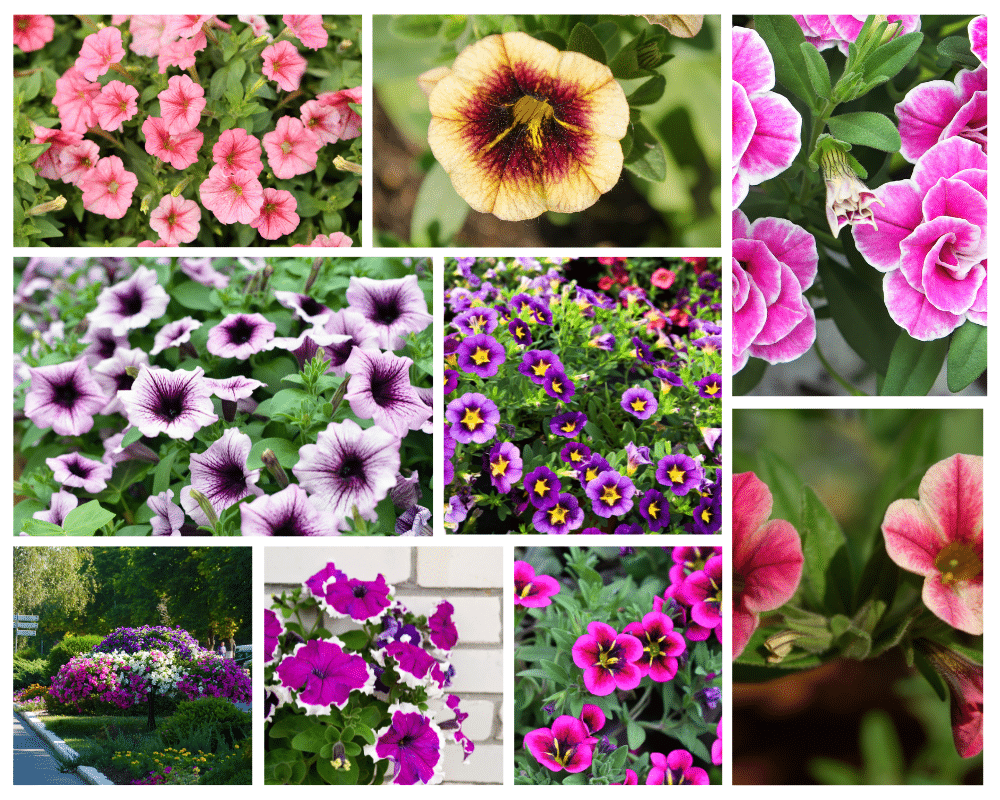
This is the fun part! With dense growth habits and an enormous range of colors and designs, you can create something beautiful. Check varieties to ensure the plant suits your needs. Lower, spreading plants will cover the ground quickly, and trailing plants will spill from your containers.
Take advantage of the range of colors and don’t overlook the unique patterns available in the blossoms.
Petunia Features
Color
The well-known trumpet-shaped blooms of the petunia are available in many colors, white, pink, purple, red, yellow, and yes-blue! You can find them in patterns including bi-colored and patterns. There is a new cultivar with what appears to be white snowflakes on a solid background.
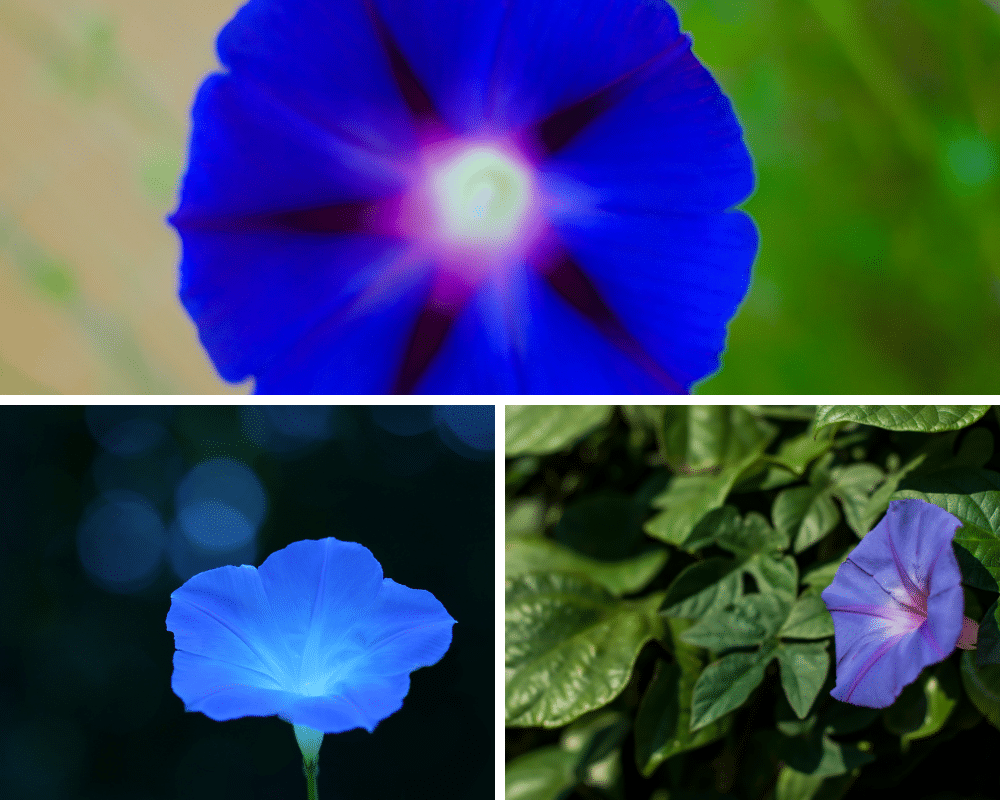
The availability of blue-blooming plants is always a challenge in the garden. There are choices of blue petunias, they are rare but available.
Here is an example from the Ball Co. research.
Go here for my work on Blue Flowers for Florida and other warm climates.
There are both single and double-flowering varieties. The double varieties are lush and lovely. (The double plants, are not, however, pollinator attractors, simply because the pollinators cannot access the nectar and pollen.) In all three of these plant choices, there are constantly new features being developed every year.
Types and Sizes
There are four main types of petunia for us to choose from.
Grandiflora
The oldest type of petunia, the grandiflora is appreciated for its enormous blooms, with diameters as wide as 5.” They do not, however, have long lifespans and tend to fail before a hot summer is over. Enjoy the grandiflora for it’s impact while you have it!
(Cultivars of desirable plants are often developed in series. A series is a group of plants with uniformity of size and flowering habit. Each member has a unique difference, usually color.) The large Grandiflora petunias are available in the following series.
These are your choices among the Grandiflora type:
- Ultra
- Dream
- Storm
- Daddy
- Supermagic
- Supercascade
Multiflora
Multiflora petunias are hardy, with their smaller size and smaller but numerous blooms and sturdy stems they are resistant to humidity, rain, and heavy wind. (Note here that while petunias are less successful than the two competitors in heavy rain some varieties are more resistant. Also, new varieties of all these plants are constantly being improved.
Multiflora series petunias include these:
- Celebrity
- Carpet
- Horizon
- Mirage
- Primetime
Milliflora
Milliflora petunias are small plants (8″x 8″) designed for hanging baskets. They are early bloomers.
Wave (or spreading)
These will spread from 2-4′ in width and are designed for ground cover and containers.
Series names to look for in the wave category are:
- Easy Wave
- Shock Wave
- Tidal Wave
- Avalanch
Calibrachoa Features
You will see calibrachoa plants for sale under the name ‘million bells,’ or ‘trailing petunia.’ (which is confusing). They are a compact, mounding plant that will trail over the sides of your container, easily covering the whole container. If you like hanging baskets to look like a round ball of color, calibrachoa is for you!
Important virtues are the calibrachoa’s ability to withstand long humid summers, the hundreds of flowers that a single plant produces over the course of a season, and the remarkable varieties of coloration they can present in your garden. Individual flowers in my hanging baskets are multicolored and each one seems to be a little different.
The caution with these very charming plants is this: do not allow them to go unwatered for even a couple of days. Also, while they have excellent heat resistance they will not handle cold snaps. Bring the containers indoors or cover the plants.
(When covering container plants for cold protection also wrap the container to protect the roots.)
Calibrachoa are very uniform plants, well-branched, mounding, and trailing. There are at least eight categories of calibrachoa, the interesting variations being color. You will be pleasantly surprised by the colors available. If you want to make a specific color statement in your plantings calibrachoa is a good option.
The colors and patterns of calibrachoa flowers are so varied that they have specific descriptive names. Most are single plants but some have double petals, which give the appearance of miniature roses.
Look for these color options in calibrachoa:
- Eye color- this flower type has a ring of contrasting color at the center.
- Veil pattern-in this form the veins of the flower contrast with the background shade. They have a watercolor look.
- Painted design- here, the vein color appears to spread to the base of the petal.
- Star pattern- this one is rare.
- Streaked pattern,- in this design streaks of contrasting color appear to start at the throat and extend to the edge of the petal.
- Splatter design- contrasting colored splatters appear on the petal.
Petchoa Features
The newest plant is the petchoa, with many, midsized blooms and the mounding and trailing growth habit we favor in beds and containers and their resiliency solves many of the longevity problems. Petchoa has strong roots with pH resiliency, and the foliage is resistant to heat and cold stresses. The foliage is less hairy and sticky than the petunia and is low maintenance, requiring little or no deadheading. The bloom is medium-sized, larger than that of the calibrachoa, and smaller than the petunia.
Beautical Series
In this plant the blossoms change color depending on light and temperature.
Calitunia Series
Expect a dense herbaceous, plant with a trailing growth.
Supertunia Series
Two-inch flowers with foliage in a rich green color. Bred for heat, cold, and stress tolerance there are as I write, eleven color varieties.
Summary,
Depending on your climate and what is important to you any of these three plants, the petunia and its relatives, the calibrachoa or the petchoa, can make you happy. In addition, each has specific features to suit your garden.
The three facts to understand in comparing and contrasting the petunia and its relative plants ( the calibrachoa and the petchoa) are these:
- Water: all three require regular water, and the calibrachoa is the most sensitive to failure to water. In hot, dry, or windy weather you may water daily.
- Drainage: the plants require excellent drainage, soil with sand will drain fastest and clay the slowest.
- Fertilizer: the production of intense flowers requires regular nutrition, expect to fertilize each on a regular basis. Use a balanced fertilizer and note that the spreading varieties have the greatest need for fertilizer.
Will you grow, or have you grown any of these three plant choices: Let me know what you think and how your project goes?
References You Can Use
Growing Annuals in Florida-a wonderfully useful guide with tables showing plants with their growing months for all parts of Florida. We used this to plant a large entry in our community.
‘How To Blend Annual Bedding Plant Into The Garden
Growing Annuals, Perdue University
Choosing Soil and Potting Soil
